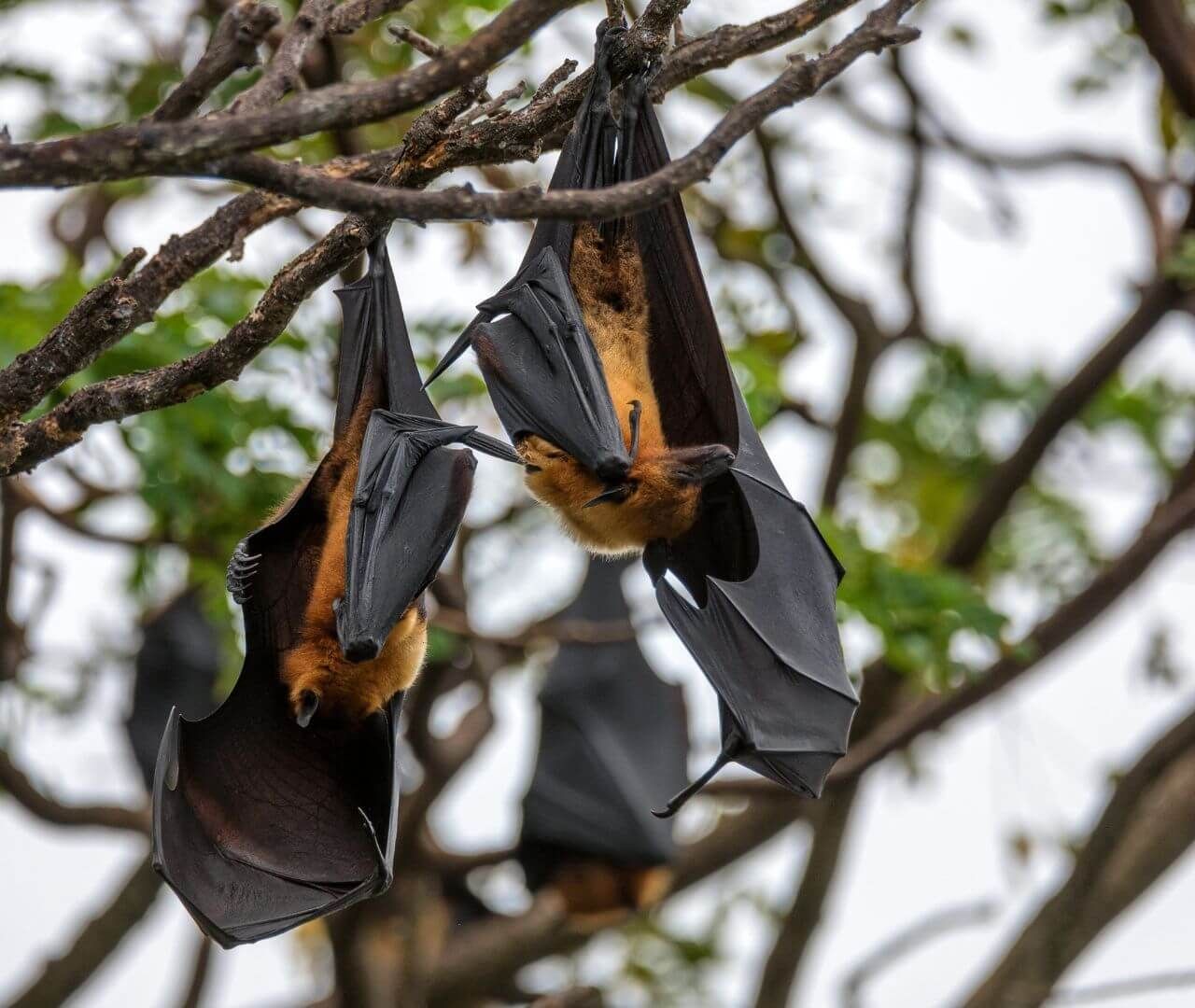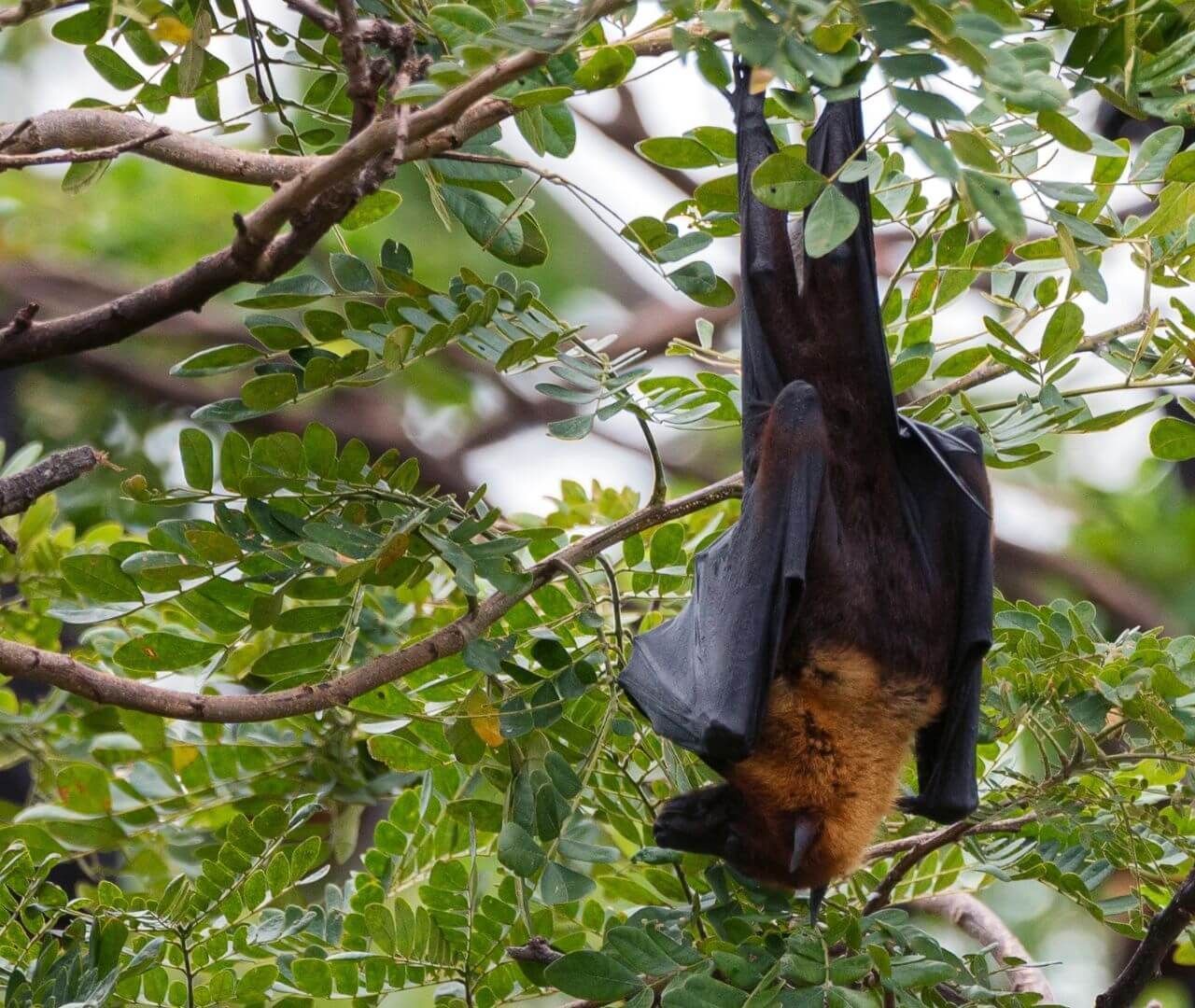Flying Foxes
Let's Learn About Flying Foxes
Word of the Week
Frugivore
A frugivore is an animal that eats primarily fruit. Flying foxes, toucans, and orangutans are all examples of frugivores.
When eating fruit, frugivores often eat the seeds inside, then spread seeds around the ecosystem in their waste. This makes frugivores important seed dispersers.
Fast Facts
Where do flying foxes live?
Flying foxes live in parts of Asia, Africa, Australia, and several small islands in between.
These large bats inhabit temperate and tropical regions. They are often found near forests and woodlands where they have space to roost and feed.
What do flying foxes eat?
Most flying foxes are frugivores or nectarivores.
Frugivorous flying foxes have a diet of mostly fruit. These bats are often important seed dispersers. Nectarivorous flying foxes have a diet of mostly nectar from flowers. These bats are often important pollinators. Flying foxes may also eat other plant parts and insects.
What traits do flying foxes have?
Flying foxes are well-known for their...
- Enormous size.
- Strong senses of smell and sight.
- Nocturnal lifestyle.
- Relatively long lifespan.
- Ability to destroy crops.
How many flying foxes are there?
There are roughly 60 species of flying foxes.
Many species of flying foxes have large populations and are not at risk of extinction. Unfortunately, many species have been hunted and affected by habitat loss, causing them to become endangered or even extinct.
Species Spotlight
Indian Flying Fox
Pteropus medius
Indian flying foxes are the largest bat in India and one of the largest in the world. Their wingspan measures almost 5 feet across (that's larger than most 5th graders)! While their large size makes them easy to spot, so does their large group size. Indian flying foxes roost in the treetops of tall trees in camps with several thousand bats! They often use the same roosting site for many years. Like most bats, Indian flying foxes are nocturnal. As the sun sets, thousands of Indian flying foxes take to the sky to look for food.
Indian flying foxes are also called greater Indian fruit bats because of their fruit-filled diet. They also feed on nectar. Both of these food choices cause Indian flying foxes to be an important part of their ecosystem. Like many frugivores, Indian flying foxes are seed dispersers. When they eat fruit, they also eat the seeds inside. As they fly around the forest, they drop seeds in their scat that grow into new plants and keep the forest healthy. When eating nectar, Indian flying foxes pollinate flowers. As they move from flower to flower, they spread pollen, which is necessary for plants to make seeds!
Because Indian flying foxes play such important roles in their habitat, they are an important species to protect. However, like many species of flying foxes, Indian flying foxes are seen as a pest because they feed on fruit crops like mangos and guavas. Farmers hunt the flying foxes to protect their crops. Some farmers have started using new methods that keep their crops safe without harming flying foxes! Read the Conservation Corner below to explore how new crop-protection methods are working to save Indian flying foxes and their habitat.
Conservation Corner
The Issue With Frugivores
Frugivores are animals that mostly eat fruit. They often eat the seeds inside the fruit, as well. As they travel around their environment, they spread seeds in their scat. This seed dispersal is important for keeping ecosystems healthy and filled with plants.
While many ecosystems would not be healthy without them, frugivores don't always get the best reputation. Flying foxes and other frugivores that live near cities, towns, and farms are often known as pests. It is one thing for a few animals to steal apples from a tree in someone's yard, but it becomes a bigger problem when thousands of animals steal fruit from farms. Farmers spend all year growing their fruit crops and rely on selling them to earn a living. When frugivores like flying foxes (which can be found in groups of several thousand) invade a farm, they do serious damage.
When humans and animals live too closely and start negatively affecting each other, we call it human-wildlife conflict. Another example of human-wildlife conflict is when wolves prey on farmers' livestock. Human-wildlife conflict is bad for both people and wildlife. Scientists work with farmers and communities to create new ways to resolve these issues.
To protect farms from flying foxes, some farmers have started to place nets around their crops to keep the bats out. Some are using bright nighttime lights to keep the bats away. Others have started harvesting their fruit early before bats can get to them. Many new methods are waiting to be discovered that will allow people and wildlife to co-exist.
Flying Fox Hangman
Play hangman to uncover these 5 sentences about flying foxes.
Learn More!
Glossary
Adaptation
The process by which a species becomes more fit for its environment over the course of several generations. It is a result of natural selection.
Crop
A plant that is grown as food.
Fledge
A young bird (or bat) developing enough to fly and leave the nest.
Frugivore
An animal that primarily eats fruit.
Human-Wildlife Conflict
An issue that occurs when humans and wildlife life too closely together and negatively affect each other.
Mammal
A group of endothermic (warm-blooded) vertebrates that are covered in hair, produce milk for offspring, and generally give birth to live offspring.
Nectarivore
The animal that feeds primarily on nectar from flowers.
Nocturnal
Used to describe animals that are awake at nighttime.
Pollinator
An organism that transfers pollen between flowers allowing them to create fertile seeds.
Predator
An animal that hunts other animals for food.
Prey
An animal that is hunted and eaten by another animal.
Roost
An area used for rest (typically of birds and bats).
Seed Disperser
An animal that spreads seeds around the environment (often in their waste or attached to their fur/feathers).
Species
A closely related group of animals with similar characteristics that are capable of reproducing (example: tigers).
Vertebrate
An animal that has a backbone.










